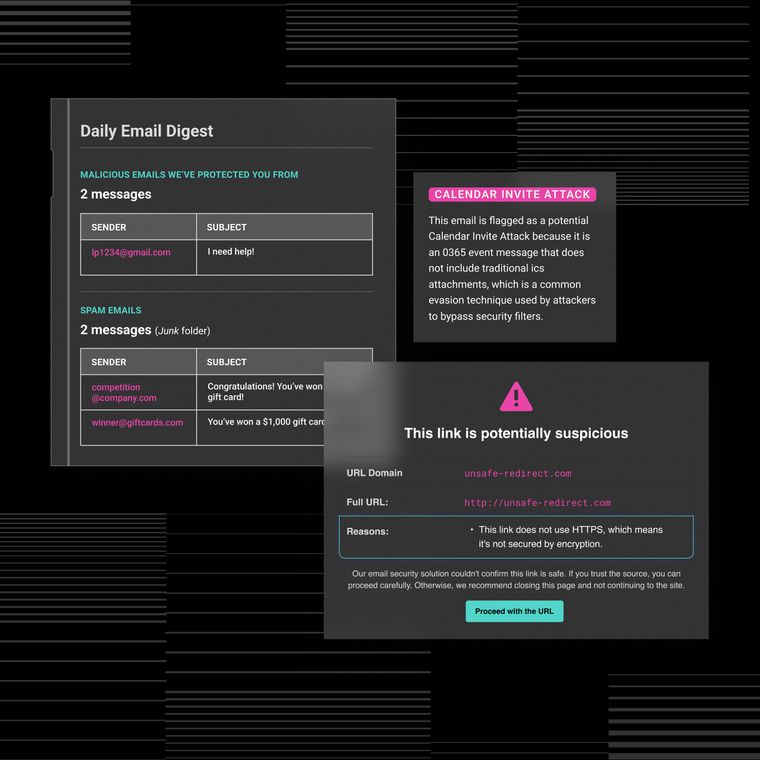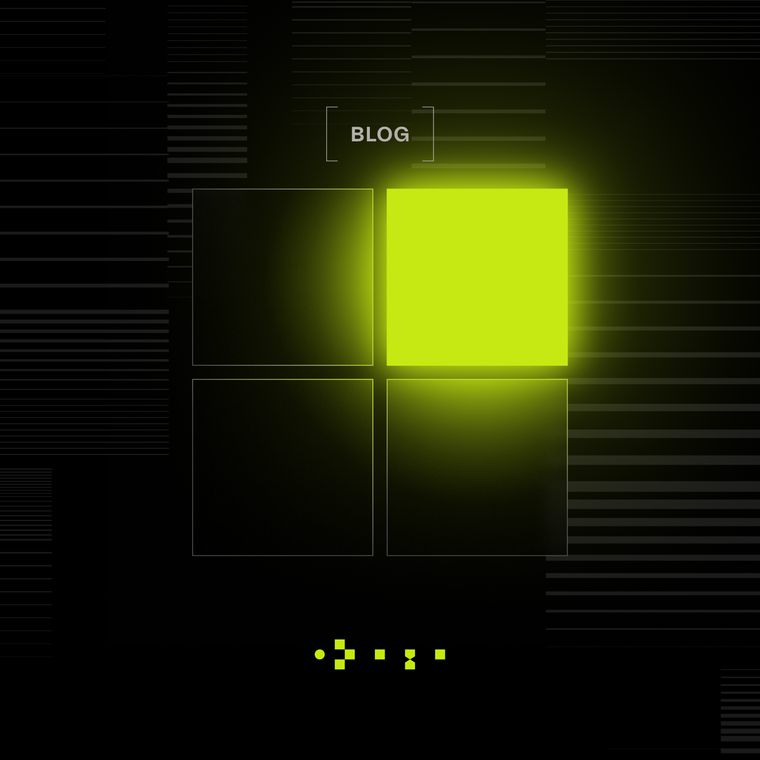Threat Detection Best Practices for Slack Security
Ensure Slack security with top threat detection practices to protect your team and prevent cyber threats.
September 22, 2025
Security teams must protect collaboration platforms where thousands of messages, files, and integrations flow daily through channels that connect employees, contractors, and external partners. Attackers target these communication hubs through sophisticated techniques, such as compromised accounts masquerading as trusted colleagues, malicious OAuth apps requesting excessive permissions, and social engineering campaigns that exploit the speed of real-time messaging. These threats blend into normal collaboration patterns, such as those found in Slack, making detection particularly challenging without specialized behavioral monitoring.
Organizations need comprehensive visibility across their Slack workspaces to identify anomalies before data exfiltration or account compromise occurs. Advanced threat detection extends beyond basic authentication to analyze communication patterns, application behaviors, and file-sharing activities that indicate potential security incidents. This guide provides five proven practices that enhance threat detection capabilities.
What Makes Slack Environments High-Value Targets for Attackers
Slack environments contain strategic planning discussions, customer data, and financial information accessible through a single compromised account. Enterprise implementations typically integrate with dozens of business applications, creating expanded attack surfaces through API connections, OAuth apps, and webhook endpoints that each represent potential entry points for malicious actors.
The platform's real-time messaging format creates optimal conditions for social engineering. Attackers impersonate trusted colleagues using familiar communication patterns, leveraging existing channel context and ongoing conversations to craft convincing scenarios that employees rarely question. These targeted campaigns bypass traditional email security controls because they operate within an already-authenticated environment.
Security incidents on collaboration platforms trigger cascading impacts, including lost productivity during incident response, regulatory scrutiny for data exposure, and erosion of employee trust in digital tools. The convergence of centralized sensitive data, extensive third-party integrations, and inherently trusted communication contexts transforms these environments into high-value targets where a single compromise yields enterprise-wide access.
Why Traditional Security Approaches Fall Short for Slack
Traditional security controls rely on signature-based detection that misses behavioral anomalies indicating compromised accounts or insider threats within collaboration platforms. These conventional tools scan for known malware patterns while attackers operate through legitimate Slack features like sharing files, creating channels, and messaging teammates using authorized credentials.
Perimeter defenses protect against external threats but cannot detect malicious activity originating inside trusted workspaces. Once attackers gain access through stolen credentials or OAuth tokens, they move freely within authenticated environments where their actions appear normal to legacy security systems.
Slack's real-time, conversational dynamics require behavioral analysis that understands context, communication patterns, and relationship graphs. Static pattern-matching cannot differentiate between legitimate urgent requests and sophisticated social engineering attempts that exploit workplace communication norms. Modern threat detection must analyze subtle deviations in messaging behavior, access patterns, and integration usage to identify threats.
That said, here are the five threat detection best practices for establishing Slack security in your organization:
1. Deploy Comprehensive Audit and Accountability Controls
Enterprise Slack environments generate massive volumes of security-relevant events that require systematic monitoring for threat detection and compliance purposes.
Comprehensive audit controls based on NIST frameworks transform this data into actionable intelligence. Organizations must collect real-time audit logs covering user authentication, file sharing, channel creation, and administrative actions across all workspaces. These logs feed into centralized SIEM platforms that provide tamper-evident storage with cryptographic integrity protection, ensuring evidence remains admissible for investigations and compliance audits.
Behavioral analysis systems correlate these audit streams to detect suspicious patterns invisible to single-point monitoring. Unusual access sequences, bulk data downloads outside business hours, and administrative changes that deviate from established baselines trigger automated alerts. This multi-layered approach identifies insider threats and compromised accounts that traditional monitoring misses.
The combination of comprehensive logging, centralized correlation, and behavioral analysis delivers three critical outcomes, including rapid threat detection through real-time alerting, streamlined regulatory compliance reporting with complete audit trails, and preserved forensic capabilities that support thorough incident investigations.
2. Implement AI-Powered Behavioral Analytics
Traditional signature-based tools are unable to detect sophisticated insider threats, account compromise scenarios, or social engineering attacks that exploit Slack's conversational nature. AI-powered behavioral analytics addresses these gaps by learning normal communication patterns and identifying subtle deviations that signal malicious activity.
User and Entity Behavior Analytics (UEBA) establishes machine learning baselines for every user. These baselines include typical login times, communication frequency, channel participation, and file-sharing habits. When accounts suddenly access sensitive channels at unusual hours or download bulk data outside established patterns, the system triggers immediate alerts. This continuous learning approach adapts to legitimate behavior changes while maintaining sensitivity to genuine threats.
Advanced analytics engines examine multiple threat dimensions simultaneously. Natural language processing identifies phishing attempts hidden in casual conversation, graph analysis reveals abnormal relationship patterns suggesting compromised accounts, and temporal analysis catches timing anomalies that indicate automated attacks or unauthorized access. These layered detection methods work together to surface threats that single-point analysis would miss.
This comprehensive behavioral approach transforms security operations: false positives tend to drop as machine learning refines detection accuracy, while automated response capabilities contain routine incidents without human intervention.
3. Deploy Centralized Security Control Framework
Security teams struggle to manage multiple collaboration platforms through separate administrative consoles, creating blind spots and inconsistent protection across communication channels.
A centralized security framework solves this problem by consolidating Slack, Teams, and other platform controls into one management system. Administrators configure security policies once and apply them everywhere: access controls, data loss prevention rules, and compliance settings automatically sync across all collaboration tools. This approach eliminates the confusion of juggling multiple interfaces.
Centralized controls also automate routine security tasks. When employees leave the company, their access revokes across all platforms instantly. Security alerts from different collaboration tools flow into one dashboard for faster threat detection. Compliance reports pull data from every platform automatically, saving hours of manual compilation. These unified systems reduce administrative work while ensuring consistent security policies protect every conversation, file, and channel across your collaboration environment.
4. Enable Regulatory Compliance Integration
Modern businesses navigate multiple compliance requirements across healthcare, privacy, and financial regulations. Each framework requires different controls, documentation, and reporting standards, which create operational complexity.
Integrated compliance systems manage these requirements through unified controls. Automated encryption protects sensitive communications across all channels. Data classification engines identify regulated information instantly, applying appropriate protection based on content type. Access controls adjust dynamically when financial data, health records, or personal information enters conversations.
Automation eliminates manual compliance tasks. Sensitive messages receive encryption automatically. Restricted documents trigger access limitations without administrator intervention. External sharing stops when protected data is detected. Compliance reports are generated on demand, documenting security measures for the benefit of auditors and regulators. Organizations maintain continuous compliance through behind-the-scenes enforcement that protects data without disrupting workflows. Security teams focus on strategic initiatives while automated systems handle routine compliance operations across every Slack interaction.
5. Deploy Enterprise Security Infrastructure Integration
Security teams operate in silos when Slack threat detection remains disconnected from existing enterprise security tools. This isolation delays incident response and creates dangerous visibility gaps.
Integration frameworks connect Slack monitoring with your broader security infrastructure. API connections feed Slack events directly into the SIEM platform, where they correlate with network, endpoint, and email security data. Suspicious Slack activity triggers automated playbooks that lock accounts, quarantine files, and alert security teams simultaneously.
This orchestrated approach transforms incident response. A compromised account detected in Slack immediately triggers password resets across all systems. File-sharing violations launch automated investigations pulling data from multiple security tools. Security teams see complete attack chains instead of isolated alerts. Organizations achieve faster threat containment through connected systems that share intelligence and coordinate responses automatically.
Building Resilient Slack Security Through Integrated Threat Detection
Organizations need specialized security approaches for Slack that go beyond traditional network defenses. Collaboration platforms create unique risks that standard tools cannot address.
AI-powered behavioral analytics solves these detection challenges. The technology learns normal user patterns and instantly identifies suspicious deviations. When accounts act differently by accessing unusual channels, downloading bulk data, or messaging at odd hours, automated alerts trigger immediate investigation. This continuous learning adapts to real threats while reducing false positives.
Successful security combines these capabilities into one ecosystem. Behavioral monitoring, compliance automation, and centralized controls work together. Organizations achieve complete visibility, faster threat response, and consistent protection across every Slack conversation.
Ready to strengthen your Slack security with AI-driven threat detection? Get a demo to see how Abnormal can enhance your enterprise communications security while streamlining regulatory compliance.
Related Posts
Get the Latest Email Security Insights
Subscribe to our newsletter to receive updates on the latest attacks and new trends in the email threat landscape.


